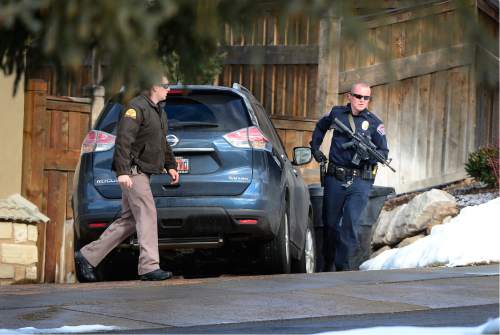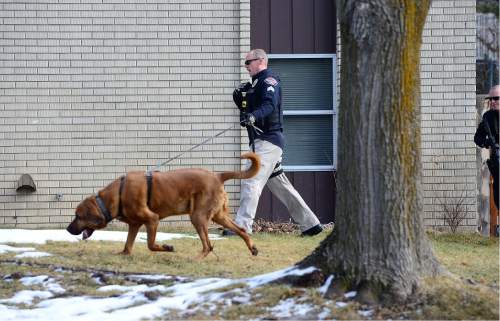This is an archived article that was published on sltrib.com in 2016, and information in the article may be outdated. It is provided only for personal research purposes and may not be reprinted.
Cory Lee Henderson — who on Sunday allegedly killed a police officer — was free at the time because he had walked away from a treatment center. Everyone who had debated whether to send Henderson to the center, rather than keeping him behind bars, had seen potential red flags.
The recording of a Dec. 7 hearing shows a federal magistrate and a prosecutor pointed to Henderson's previous failures to follow parole rules. His defense attorney acknowledged those concerns, but argued that with certain conditions, his client was "a manageable safety and flight risk."
After adding their own caveats, the prosecutor said he felt "comfortable" with the plan and Magistrate Judge Evelyn Furse ordered Henderson's release to the center.
Eleven days later, Henderson absconded. On Sunday, he allegedly shot and killed Unified Police Department Officer Doug Barney and died in a shootout with other officers, according to authorities.
Some Utah police officers are now contending that the magistrate's decision should be reviewed.
The Dec. 7 detention hearing centered on where Henderson, a parolee indicted on new gun and drug charges, should await further proceedings.
Alexander Ramos, Henderson's defense attorney, wanted Henderson sent to Fortitude Treatment Center, an Utah Adult Probation and Parole facility. Reading from its website, he noted offenders there are subject to tight restrictions and face an intensive program aimed at addressing issues causing them to struggle.
Assistant U.S. Attorney Michael Thorpe had asked at a Dec. 4 hearing to detain Henderson. Ramos asked for more research time; after he described the center at the Dec. 7 hearing, Thorpe asked that federal Probation and Pretrial Services — which helps ensure that defendants released before their trials return to court as required — assess the proposed placement. But, he added, "otherwise, I'm comfortable with this resolution."
"It does sound like there would be sufficient precautions to keep this defendant under the kind of control and guidance that I would feel comfortable with, which would mitigate the risk of flight and as well potentially mitigate the risk to the community," Thorpe said.
However, Furse did not include the requested pretrial services assessment in her order. The magistrate said she would allow Henderson to reside at Fortitude under an agreement that the center would supervise him, "use every effort" to ensure he appeared at all scheduled proceedings and notify the federal court if he violated any release conditions. She also required Henderson to follow all state parole conditions.
The center, at 1747 S. 900 West, alerted the court after Henderson didn't return from looking for work, and a warrant was issued for his arrest. The Metro Gang Unit reportedly had been seeking him in the Holladay area Saturday night, just hours before Henderson allegedly ran a red light and crashed a car at 2300 East and 4500 South at 9:50 a.m. Sunday.
Henderson had fled on foot before allegedly shooting Barney, and later shooting and wounding UPD Officer Jon Richey in an exchange of gunfire near 2100 E. 4500 South. Henderson was killed in the shootout.
Ramos, a federal defender, said Wednesday that under office policy, he cannot comment on the case. U.S. District Court Chief Judge David Nuffer has said federal judges are prohibited from commenting outside court on specific cases.
Melodie Rydalch, spokeswoman for the U.S. Attorney's office, said prosecutors requested the assessment because it was clear Furse "was going in a different direction" than their initial request for detention.
Henderson, whose record included federal and state firearms and drug-related charges, had served 14 months in state prison for possession of a firearm by a restricted person before being been paroled April 28, 2015.
But he absconded from supervision, and the parole board issued a fugitive warrant for him on June 4. He was back in prison in October due to parole violations.
At a Nov. 4 parole board hearing, Henderson pleaded guilty to allegations related to absconding from parole and was ordered to spend 60 days behind bars, the maximum punishment under sentencing guidelines for a first parole violation.
He already had served 30 days while awaiting the hearing, and he was scheduled to go to the Fortitude Treatment Center after he completed an additional 30 days in prison.
"While at Fortitude, a parolee can check out to attend schooling, go to work or to search for work and see family," its website says. "The offender is able to maintain a job, ties to family and other community connections rather than being uprooted and returned to prison."
Henderson was still serving his remaining 30 days on Nov. 24, when a federal grand jury in Salt Lake City indicted him on the new gun and drug charges, allegedly committed while he had been a fugitive.
Twitter: @PamelaMansonSLC







